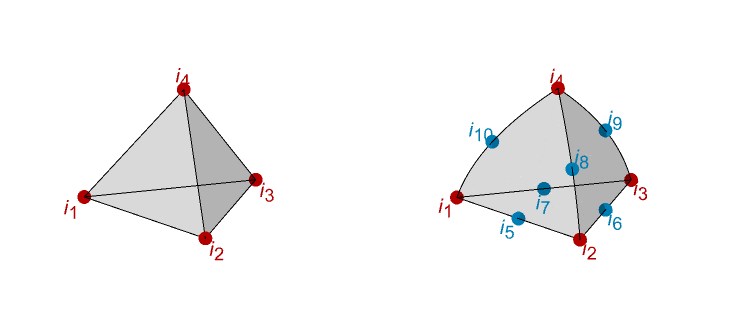TetrahedronElement[{{i11,i12,i13,i14},…,{in1,in2,in3,in4}}]
represents n linear tetrahedron elements ek with incidents {ik1,ik2,ik3,ik4}.
TetrahedronElement[{{i11,…,i110},…,{in1,…,in10}}]
represents n quadratic tetrahedron elements ek with incidents {ik1,…,ik10}.
TetrahedronElement[{e1,…,en},{m1,…,mn}]
represents n tetrahedron elements ek and n integer markers mk.


TetrahedronElement
TetrahedronElement[{{i11,i12,i13,i14},…,{in1,in2,in3,in4}}]
represents n linear tetrahedron elements ek with incidents {ik1,ik2,ik3,ik4}.
TetrahedronElement[{{i11,…,i110},…,{in1,…,in10}}]
represents n quadratic tetrahedron elements ek with incidents {ik1,…,ik10}.
TetrahedronElement[{e1,…,en},{m1,…,mn}]
represents n tetrahedron elements ek and n integer markers mk.
Details and Options
- TetrahedronElement is used to represent tetrahedron mesh elements in ElementMesh.
- TetrahedronElement can be used as an input to ToElementMesh.
- Incidents ik,j are integers that index an array of spatial coordinates. The coordinates referenced by ek={ik1,…} are the nodes of the k
 tetrahedron.
tetrahedron. - The first four incidents ik1, ik2, ik3, and ik4 are always vertices.
- For quadratic tetrahedron elements, the next six incidents are mid-side nodes of possibly curved edges.
- Linear elements are order 1 elements and quadratic elements are order 2 elements.
- In TetrahedronElement[{e1,…,en}], all elements ek need to be of the same order.
- The tetrahedra in TetrahedronElement[{e1,…,en}] will share common nodes, edges, and faces but cannot intersect with each other, or for second-order tetrahedra, with themselves.
- The nodes for a linear and a quadratic tetrahedra are shown:
- For a TetrahedronElement, the face incidents opposite a vertex ij must be counterclockwise. An element {i1,i2,i3,i4} has the face incidents {i4,i3,i2}, {i4,i1,i3}, {i4,i2,i1}, and {i1,i2,i3} for the four faces.
- The tetrahedron element is known in the finite element method as a Serendipity element.

Examples
open all close allGeneralizations & Extensions (4)
The base coordinates of the linear element:
The base incidents of the linear element:
A mesh with a linear unit element:
Visualization of the linear unit element:
The base coordinates of the quadratic element:
The base incidents of the quadratic element:
Applications (1)
Possible Issues (6)
Tech Notes
Related Guides
Text
Wolfram Research (2014), TetrahedronElement, Wolfram Language function, https://reference.wolfram.com/language/FEMDocumentation/ref/TetrahedronElement.html.
CMS
Wolfram Language. 2014. "TetrahedronElement." Wolfram Language & System Documentation Center. Wolfram Research. https://reference.wolfram.com/language/FEMDocumentation/ref/TetrahedronElement.html.
APA
Wolfram Language. (2014). TetrahedronElement. Wolfram Language & System Documentation Center. Retrieved from https://reference.wolfram.com/language/FEMDocumentation/ref/TetrahedronElement.html
BibTeX
@misc{reference.wolfram_2025_tetrahedronelement, author="Wolfram Research", title="{TetrahedronElement}", year="2014", howpublished="\url{https://reference.wolfram.com/language/FEMDocumentation/ref/TetrahedronElement.html}", note=[Accessed: 08-December-2025]}
BibLaTeX
@online{reference.wolfram_2025_tetrahedronelement, organization={Wolfram Research}, title={TetrahedronElement}, year={2014}, url={https://reference.wolfram.com/language/FEMDocumentation/ref/TetrahedronElement.html}, note=[Accessed: 08-December-2025]}